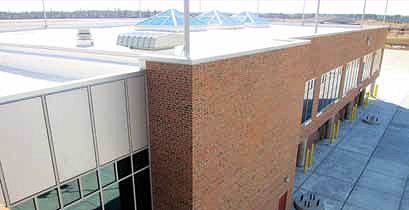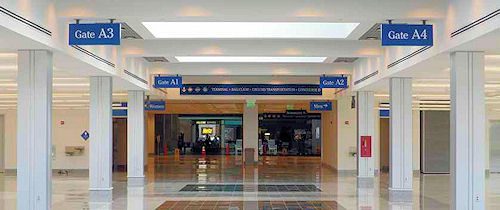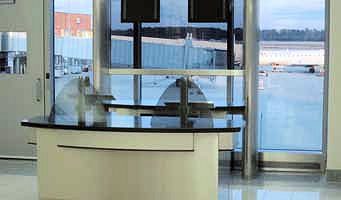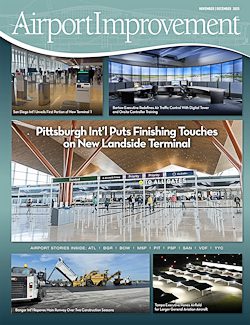|
An open floor plan allows travelers to spread out from the gates, yet still watch for boarding activity. |
|
Facts & Figures Project: Concourse Addition Location: Newport News/Williamsburg (VA) International Airport Cost: $13 million Owner: Peninsula Airport Commission Primary Contractor: W.M. Jordan Company Design Architect & Architect of Record: Shriver and Holland Associates Sign Design Consultant: Sign Media Signage Subcontractor: Architectural Graphics Seating Manufacturer: Arconas Seating Distributor: Hampton Stationery and Office Furniture Gate Counter: Jensen Cabinet Benefits: Increased capacity, future capabilities for international traffic Project: Runway Rehabilitation Location: Newport News/Williamsburg (VA) International Airport Cost: $16 million Contractor: Rifenburg Construction Runway Design Engineer: International Airport Consultants Benefits: Increased safety |
A Modern Touch
PHF’s new two-story concourse includes six additional gates for Category 3 aircraft (737 to 800). The addition of the 38,000-square-foot concourse brings the airport’s passenger terminal facility to 179,000 square feet.
“We tried to capture a lot of the newer concepts and be a little bit more energy-efficient,” Spirito says.
Multiple windows and skylights bring in natural lighting. While the original terminal has one large pyramid skylight, the new concourse has three smaller pyramid skylights.
The architect of record for the project, Matthew Shriver of Shriver and Holland Associates, says the modern interior is an extension of the original 18-year-old terminal building. Natural granite flooring harmonizes with the terrazzo flooring, and colors remain fairly neutral, mostly warm grays.
Mike DuBose, project manager for W.M. Jordan Company, describes the project’s construction materials as “extremely high quality.” Colonial brick was used outside; inside finishes include granite flooring, metal-panel column wraps and stainless-steel gates.
Upstairs, the new concourse seats about 500 passengers. An open floor plan allows travelers to sit farther from the gates, yet still watch for boarding activity.
“After people go through security, they want to relax,” Shriver comments.
Flyaway seating from Arconas provides passengers with a convenient place to recharge electronic devices such as laptops, iPods and PDAs while they wait for flights. The six-seat cluster unit features a built-in power source within arm’s reach under the central tabletop.
Gate counters, by Jensen Cabinet, were also made to be user-friendly. A universal design with a low counter makes them wheelchair accessible.
The new concourse is home to Frontier Airlines, which is the airport’s newest airline, and AirTran Airways, its largest carrier with about 50% of the airport’s market share. When necessary, the two airlines can both use a gate counter at the same time. Understanding that airlines like to use their own IT systems, PHF configured the space so each airline uses its own computer and corporate IT network at separate customer service positions.
“We tried to be more flexible in using gates for different airlines with different strategies and different frequencies,” Spirito says.
Ken Spirito
Terminal Updates

The modern interior and technological advantages of the new concourse have spawned changes throughout the airport terminal.
All bathrooms have been updated with touchless technology to create a healthier environment. Now, the wave of a hand can flush a toilet or turn on a water faucet.
The new concourse’s clean look inspired a facelift in other areas of the terminal, too. Seating was updated throughout the atrium and original concourse. Old signage was changed to address the airport having two concourses and lettering was changed to match the airport’s logo. Gates previously labeled 1-4 are now B1-4; new gates are named with A prefixes.
Colonial brick builds on Virginia’s history, while skylights with metal accents convey a modern feel.
Challenges Faced

According to Shriver and DuBose, the concourse project was straightforward and included very few change orders.
Crews did find buried debris, wood and concrete under the building pad that had to be excavated. (PHF was built on land that was part of the U.S. Army’s Camp Patrick Henry during World War II.)
Although ample subgrade earthwork was required, DuBose says the granite on the second floor was more of a challenge.
“You have to have an extremely flat floor to be able to put granite tile in,” he explains.
The customer service stations were also a little tricky because they have stainless-steel cladding, which required the casework fill contractor to put them together without oil canning.
On top of it all, the ceilings are not fixed to the walls. They literally hang there, which also required extra care and diligence.
From Spirito’s perspective, funding was a challenge.
“We didn’t do everything that we wanted to do in this project,” he says.
|
Gate counters, by Jensen Cabinet, have a universal design to meet the diverse needs of customers and airlines. |
The timing of PHF’s most recent projects proved to be a plus. Current economic conditions allowed the airport to obtain funding and get more building for its dollar, thanks to competitive bids from contractors.
“We were able to get some of the things we probably wouldn’t have been able to get otherwise, like the square footage,” notes Spirito.
Runway Rehab
Rehabilitation of Runway 7-25, designed by International Airport Consultants, was an even bigger improvement project than the concourse addition. The entire 8,000-foot-by-150-foot concrete runway needed to be repaved because it had deteriorated with extensive spalling and cracking. During the rehabilitation, an asphalt overlay of 2 to 9 inches was applied on top of the existing runway surface.
Rifenburg Construction completed the runway work in two phases. Phase 1, involving the northern section of the runway, began in August 2008 and was finished in mid-September 2008.
Because 7-25 is the airport’s only runway with an Instrument Landing System, the project required extra precautions.
“If a cloud ceiling developed, the runway would need to be ready for takeoffs and landings within 24 hours,” explains Rifenburg’s Brian Birdsall.
To prepare for such circumstances, Rifenburg made sure there were no drop-offs and tied in open edges. A cloud ceiling developed only once during Phase 1, but it brought a “deluge of rain” and lasted five days, recalls Birdsall.
Phase 2 included the southern section and intersection. Work began in early October 2009 with taxiway demolition, suspended just before Thanksgiving, and resumed with excavation and drainage pipe work in April 2010. Completion is expected this May.
|
Melissa Mullholland |
To address the challenge, Rifenburg proposed an alternate idea for phasing. Instead of crews working in five-hour shifts at night for 180 days as originally planned, they worked day and night during a 10-day shutdown.
“During this time, planes would land on a shortened, displaced threshold,” explains Birdsall. “In another 10-day shutdown of 7-25, we would give them the intersection back, let them use 2-20 and finish tying Phase 1 to Phase 2.”
The engineer, airport and airlines all approved Rifenburg’s proposal at a preconstruction meeting.
“The selling point was less disturbance to the runway,” Birdsall explains. “There are a lot of risks to opening a runway every morning at 5:30, day after day. Shutting the runway down for 10 days, you risk not opening the runway just once.”
The next challenge was finding 10 days of good weather, which occurred in November and ended the Friday before Thanksgiving.
During Phase 2, Rifenburg brought in its own asphalt plant. On-site production not only helped control the quality and distribution of asphalt, it also allowed crews to move more quickly.
In Phase 1, Rifenburg paved 3,500 feet with 36,000 tons of asphalt mix and added erosion control. In Phase 2, Rifenburg paved the remaining 4,000 feet of 7-25 and the intersection area with 65,000 tons of asphalt.
Designs are currently in the works to relocate the airport’s lighting vault and transition from conventional lighting to LEDs.
So far, says Mulholland, the overall project has been accomplished efficiently and improved the safety of the airport for the long term.
What’s to Come
Taking a moment to reflect on the airport’s many expansion efforts, Spirito is proudest of PHF’s foresight to plan for future growth.
“Air service development is more competitive than it has ever been,” he relates. As airports work to keep their existing service, he says they should also be ready with facilities in place for opportunities to add new service.
“I’m proud of the fact that we moved forward with a development during a time when people probably thought airports were crazy to bring on new capacity,” he explains. “But we have to take advantage of opportunities when they come. If you don’t have space for a new airline, for example, you may miss out on an opportunity.”
The new PHF concourse is designed to receive international aircraft as large as a Boeing 767, and the ground level is shelled out for international traveler processing.
“We are planning on hopefully bringing in some international flights, and we wanted to be sure that we had the capacity to handle that,” Spirito says.
He sees an opportunity to improve the traditional way larger hubs process international travelers. “There’s a significant time and distance factor when you get off an aircraft and clear Customs,” he says.
PHF’s facilities can be designed to offer one-stop clearance, without a long walk to Customs and Immigration.
“It makes the process more efficient and easier for passengers, and it allows us to utilize less space,” he says.
Deplaning passengers would take escalators downstairs to a Customs/Immigration area then return upstairs to claim their bags.
And There’s More
On the landside, PHF is fixing deficiencies associated with its 18-year-old building and is working to make the terminal more convenient. The USO was recently expanded, and a new welcome center is in the works. Outdoors, covered escalators are being added to connect the terminal and parking lot.
“We’re looking at every aspect of our business, both on the airside of the terminal and the landside, to ensure we have a product for the customer that’s competitive and low-cost,” Spirito explains.
The local economy in Newport News has not been hit as hard as others because of government and military traffic from Hampton Roads, he notes.
|
Jessica Wharton |
A new Facebook page updates travelers about everything going on at the airport.
Despite the growth and many changes at PHF, airport officials want people to know some things haven’t changed. From shuttle buses that pick passengers up at their cars, to free baggage carts to good customer service and clean facilities, the airport is still the same at the core, notes Jessica Wharton, PHF director of marketing and public affairs.
“We offer a place that people want to come back to,” Wharton says. “As we continue to grow, we still want people to have that convenient, smaller airport feel.”






